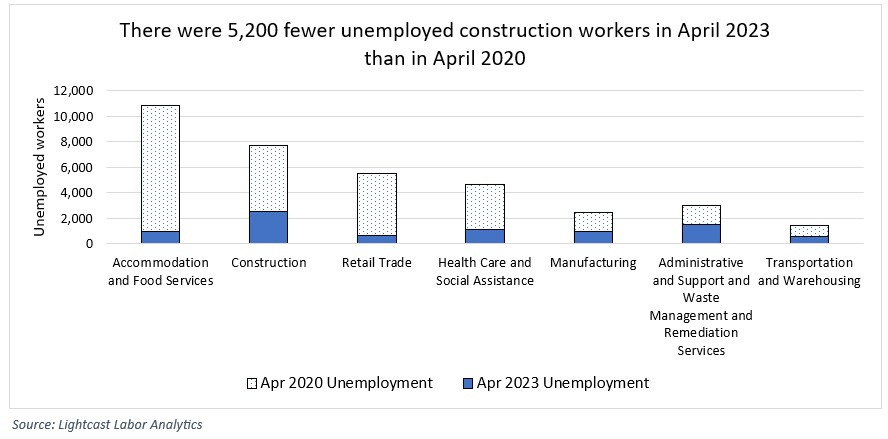Hard Hats are in High Demand
Employment in the Capital Region's construction sector is showing a strong post-COVID rebound
From the peak of pandemic-era unemployment to today, people have come back to work in droves. Since April 2020, employment in Baton Rouge has grown by 41,000 workers while unemployment has fallen by 33,000. The difference between those – about 8,000 workers – shows that Baton Rouge’s labor force has grown, too. The Capital Region’s expanding labor force, which tallies up all employed workers and all unemployed workers seeking employment, is a testament to our growing population (yes, the BR Metro is getting bigger) and the region’s strong labor market which has brought thousands of people from the economic sidelines back into the labor force.
One industry in which this comeback has been particularly pronounced is the construction sector. Jobs in construction have grown by eleven percent over the last twelve months alone, double the rate of the BR Metro’s next fastest-growing industry. Baton Rouge was home to 7,700 unemployed construction workers in April 2020; by April 2023, that had fallen to just 2,500.
While this may seem intuitive, it deserves some emphasis. The construction sector plays an important role in any expanding economy, but it’s especially foundational in Baton Rouge thanks to the needs of our industrial facilities. The Capital Region has won billions of dollars in industrial and transitional energy projects over the last few years, but these facilities will not be able to start processing feedstocks, manufacturing chemicals, or capturing carbon until they’re actually built. That’s where the construction sector comes in.
Total jobs in Baton Rouge’s construction sector are up 6,100 since January 2020, right before COVID upended the economy. Looking at subsets of the construction sector, heavy & civil engineering construction jobs are up 16% while building construction jobs are up 51%. Jobs in specialty trades, which includes electricians, specialty welders, and painters, fell by 23% between January and July 2020, making this subset the hardest-hit by COVID. Today, specialty trade contractors have almost fully recovered to pre-pandemic levels.
The construction sector’s rebound has put a lot of workers back to work. By April 2023, there were 5,200 fewer unemployed construction workers in the Capital Region than there were in April 2020. That’s the second-largest net decrease in unemployment among all industries in Baton Rouge after the accommodation/food services industry. The biggest difference between these two sectors? Wages.
In Q1 of this year, construction workers in the Capital Region brought in, on average, $1,481 in weekly wages1. That’s more than weekly average wages for government workers and health care professionals, and about $1,100 above average weekly wages for accommodation/food services workers.
One more important thing to note - construction unemployment remains high relative to other industries. Generally speaking, construction employment is more volatile than employment in other industries because, in Baton Rouge, it’s tied to investment in new and expanding industrial facilities. While there were still 2,500 unemployed construction workers at the end of this year’s first quarter, that means Baton Rouge has the workforce and the capacity to support future project announcements. And if the region can put all these workers on a jobsite, there’s more help on the way: LSU has granted more than 900 bachelor’s degrees in construction management over the last five years, and that’s just one of many sources of construction-related talent for the Capital Region.
Data from the Quarterly Census for Employment and Wages, reported by the Louisiana Workforce Commission, Q1 2023. Data covers the Regional Labor Market Area 2.





